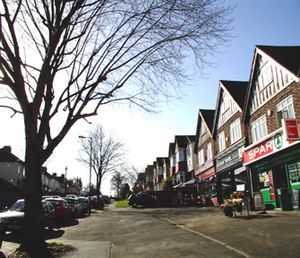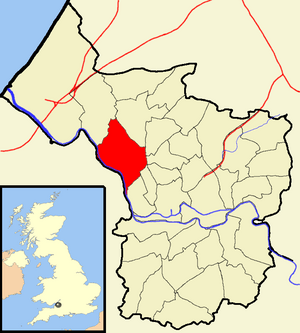Stoke Bishop facts for kids
Quick facts for kids Stoke Bishop |
|
|---|---|
 Druid Hill shops |
|
 Pre-2015 boundaries of the city council ward |
|
| Population | 9,269 |
| OS grid reference | ST563759 |
| Unitary authority | |
| Ceremonial county | |
| Region | |
| Country | England |
| Sovereign state | United Kingdom |
| Post town | BRISTOL |
| Postcode district | BS9 |
| Dialling code | 0117 |
| Police | Avon and Somerset |
| Fire | Avon |
| Ambulance | Great Western |
| EU Parliament | South West England |
| UK Parliament |
|
Stoke Bishop is an outer city suburb in the north-west of Bristol. Bordered by The Downs and the River Trym, it is located between Westbury-on-Trym, Sneyd Park and Sea Mills. Although relatively low, Stoke Bishop's population has significantly increased in recent years due to the infilling of former school and company playing fields. Moreover, the population of Stoke Bishop varies throughout the year because of the influx of students during term time to the large campus of Bristol University halls of residence situated on the edge of The Downs.
Stoke Bishop is also the name of a council ward, which includes Sneyd Park, much of The Downs and the Avon Gorge, and since 2015 most of the district of Sea Mills.
The land of Stoke Bishop was granted to the Bishop of Worcester by King Offa of Mercia in the 790s and remained a Worcester ecclesiastical estate until the Reformation. Confiscated by Henry VIII, it then passed into private hands. What is now Sneyd Park was sold as a separate Sneed Park estate in the mid-17th century. Apart from the two estate mansions and small adjoining parks, the area remained agricultural until the 19th century.
In the course of the 19th century land on both estates was increasingly sold off to wealthy Bristolians to construct large villas in substantial grounds. A separate parish of Stoke Bishop was created, including Sneyd Park, with the present parish church consecrated in 1860; a grand church (now village) hall was completed in 1885. Previously in Gloucestershire, the area was absorbed into the City of Bristol in 1904. In the inter-war period the remaining farmland was sold off, streets of detached and semi-detached houses were built, and parades of shops were constructed on Shirehampton Road (Trymwood Parade) and at the bottom of Druid Hill.
An association with Druids arose from a megalithic monument, apparently the remains of a burial chamber, discovered in 1811 off what is now Druid Hill. Druid Stoke House, a Grade II listed building west of Druid Hill, dates from the turn of the 19th century. The Druid Stoke area was developed in the grounds of Druid Stoke House in the 1930s.
Within Stoke Bishop there is a parish church, St Mary Magdalene (CofE); a primary school, Stoke Bishop C of E Primary, sometimes called Cedar Park, because of its location; and a village hall, which is used for a variety of activities from dog training to karate. Next to the primary school is Bristol Croquet Club, which has had many influential international members.
Stoke House, the Stoke Bishop manor house, was built in 1669 for Sir Robert Cann, Member of Parliament, Mayor of Bristol and Merchant Venturer. A Grade II* listed building, it is currently a theological college known as Trinity College, Bristol.
The University of Bristol Botanic Garden moved in 2005 to the grounds of The Holmes in Stoke Park Road. A large 'Arts and Crafts' style house, built in 1879, The Holmes was used as a base for US Army generals during the planning of the 1944 Normandy landings.
Stoke Bishop Adult Adult Education Centre at Stoke Lodge is a Grade II listed building built in 1836. Beside Stoke Lodge is a playing field, arboretum and children's play park. The entire site has been owned by Bristol City Council and held as educational land since 1947.
In 2011, the playing fields were leased long-term to Cotham School. These fields are the subject of a protracted legal dispute. In 2018 the High Court quashed a 2016 decision of the Bristol City Council Public Rights of Way and Greens Committee to register the playing fields as a Town or Village Green (TGV). Following this, Cotham School erected new signage and a high fence around the site, despite Ofsted confirming that it did not require perimeter fencing, as repeatedly insisted by the school. New applications were made to register the playing fields as a TVG in September 2018 and June 2019, and on 28 June 2023 the Public Rights of Way and Greens Committee again voted to register the land as a TVG. Registration as a TVG would mean that the fence had to be removed, since it is illegal to enclose a village green. Cotham School has also courted controversy by installing CCTV cameras on the playing fields. In January 2023 the Information Commissioner's Office declared these to be unlawful.
Stoke Bishop Cricket Club play at Coombe Dingle Sports Complex. The cricket club has two senior men's XIs and a junior section composed of U9, U11, U13, U15 and U17 teams.
In the 1930s Jared and Jethro Stride built "one-off luxury homes on plots they had bought" in Sneyd Park and Stoke Bishop. The tradition was carried on by Jared's sons Arthur and Frederick, and later into the 1960s by their sons Leslie and Raymond. The 'Stride brothers' specialised in constructing individual style homes with the emphasis on location, finish and design. Each house was built to a unique design - no two are the same - and well fitted out with oak floors, wood-panelled rooms and central heating. These "high quality dwellings" are still marketed today as classic 'Stride houses'.
There was a Roman harbour, Portus Abonae (port on the Avon), at the then deeper and much more extensive tidal mouth of the River Trym. Its origin was military, but by the early second century a civilian town had been established on the Stoke Bishop side of the river. Important enough to feature simply as Abona in the 3rd-century Antonine Itinerary, which documents towns and distances in the Roman empire, it was connected with Bath by a road that crossed The Downs and ran down to the harbour along what is still a right of way known as Mariners' Path. Archaeological excavations have found evidence of the street pattern and shops within the town, also cemeteries outside it in what were then the grounds of Nazareth House. The fenced-off foundations of a small building have been preserved at the Portway entrance of Roman Way. No evidence of settlement later than the Roman period has been found.
The district of Sneyd Park was built over most of the old Sneed Park estate. Renamed Nazareth House, when it was sold by the heirs of Sir George White and became a Roman Catholic Orphanage in the 1920s, the former mansion was demolished in 1972. Bombs fell on Roman Way during the Second World War, destroying one house completely.
Notable people
- Elizabeth Ayton Godwin (1817–1889), hymn writer, religious poet.
- Sir Edward Payson Wills, 1st Baronet ( 1834 - 1910 ) Tobacco Manufacturer and a director of W.D. & H.O. Wills Tobacco Company.
- José Maria de Eça de Queirós (1845–1900), Portuguese novelist who was the Portuguese consul in Bristol from 1879 to 1888.
- Sir George White, 1st Baronet (1854–1916),Tram, motor vehicle and aircraft manufacturer. Managing director of the Bristol Tramways and Carriage Company and founder of the Bristol Aeroplane Company.



